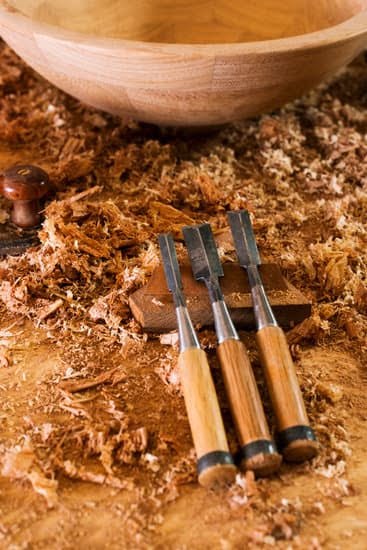Woodworking is a craft that requires precision, attention to detail, and a secure foundation to produce exceptional results. In the realm of woodworking tools, one indispensable tool stands out – the woodworker’s vise. This essential piece of equipment plays a crucial role in every woodworking project, providing stability, control, and enhanced craftsmanship.
A woodworker’s vise serves as a versatile device that securely holds workpieces in place. Regardless of the size or complexity of the project at hand, this tool ensures that materials remain fixed while woodworkers execute intricate cuts, joinery, or finishing touches. By firmly gripping the workpiece and preventing movement or slippage during the woodworking process, it allows for greater precision and reduces the risk of accidents or mistakes.
The functionality of a woodworker’s vise extends beyond mere clamping capabilities. Its rugged construction and reliable design make it an integral part of any workshop.
Whether attached to a workbench or mounted on dedicated platforms, this powerful tool provides not only a sturdy grip but also stability for both beginner woodworkers exploring new techniques and experienced craftsmen tackling complex woodworking projects. With its ability to hold objects securely from all angles and positions, it boosts efficiency while ensuring optimal safety measures are in place.
Exploring the Purpose and Functionality of a Woodworker’s Vise
A woodworker’s vise serves a crucial purpose in woodworking projects by securely holding workpieces in place. This section will delve into the primary role and functionality of a woodworker’s vise, highlighting its ability to provide stability and precision during various woodworking operations.
The Primary Role of a Woodworker’s Vise
The main function of a woodworker’s vise is to hold workpieces securely, allowing the woodworker to perform tasks with ease and accuracy. Whether it is planing, sawing, chiseling, or any other woodworking operation, having a reliable vise ensures that the workpiece remains steady throughout the process.
By firmly gripping the workpiece, a woodworker’s vise eliminates any movement or slippage that can lead to inaccuracies or safety hazards. This stability is particularly important when working with larger pieces of timber or when exerting significant force during shaping or cutting processes. In addition to enhancing safety, a well-designed vise also promotes greater precision by keeping the workpiece in optimal position for precise measurements and cuts.
Functionality and Versatility
A woodworker’s vise offers more than just securing workpieces; it also provides versatility in its functionality. Many vises have adjustable jaws that can accommodate different sizes and shapes of workpieces. This adjustability allows a woodworker to adapt the vise to different projects without needing multiple clamping devices.
Furthermore, some vises offer rotating capabilities that allow the woodworker to reposition the workpiece effortlessly. This feature is particularly useful when working on intricate joinery details or when switching between different sides of the workpiece without having to remove it from the vise entirely.
Overall, the purpose of a woodworker’s vise goes beyond mere clamping; it plays an integral part in achieving precision and stability throughout various woodworking operations. Whether you are working on small-scale projects or engaged in extensive furniture-making endeavors, investing in a high-quality woodworker’s vise can greatly enhance the quality of your craftsmanship.
Different Types of Woodworker’s Vises
When it comes to woodworking, a woodworker’s vise is an essential tool that provides stability and precision during various woodworking operations. There are several types of woodworker’s vises available, each with its own advantages and disadvantages. In this section, we will provide a comprehensive overview of the different types of woodworker’s vises commonly used by woodworkers.
- Bench Vises: Bench vises are the most common and widely used type of woodworker’s vise. They are usually mounted on a workbench and have a stationary jaw and a movable jaw operated by a screw mechanism. Bench vises are known for their versatility as they can hold both small and large workpieces securely.
- Front Vises: Front vises, also known as face vises or shoulder vises, are mounted on the front edge of the workbench. They typically have one stationary jaw at the front and another movable jaw that is adjusted using a screw mechanism. Front vises are particularly useful for holding large workpieces that need to be planed or worked on from different angles.
- Tail Vises: Tail vises, also referred to as end vises or wagon vises, are installed at the end of the workbench. They have one stationary jaw at the end of the bench and another movable jaw operated by a screw mechanism. Tail vises excel in holding long and narrow workpieces securely while allowing easy access for shaping or joinery.
- Other Types: Apart from bench vises, front vises, and tail vises, there are other specialized woodworker’s vises available in the market. These include leg or post-mounted vises that can be easily attached to any stable surface, portable or clamp-on benchtop vires that can be used on different benches or tables, pipe clamps that utilize pipes for clamping pressure, and even woodworking vises that can be integrated into workbenches for a more permanent solution.
It is important to consider the specific requirements of your woodworking projects when choosing the type of woodworker’s vise. The size and weight of the workpieces, the angles at which you need to work, and the space available in your workshop are all factors that should be taken into account. By understanding the different types of vises available, you can make an informed decision and choose the most suitable one that will enhance your woodworking experience.
Key Features and Components of a Woodworker’s Vise
A woodworker’s vise is a crucial tool in any woodworking workshop, providing stability and precision during various woodworking operations. To understand the functionality of a woodworker’s vise, it is essential to familiarize oneself with its key features and components.
One of the main components of a woodworker’s vise is the jaws. The jaws are the parts of the vise that hold the workpiece securely in place. They are typically made of sturdy materials such as steel or cast iron to ensure durability and maximize grip on different types of wood. The jaws come in various sizes and shapes, including flat, angled, and stepped jaws, allowing for versatility in clamping different workpieces.
The screw mechanism is another vital component of a woodworker’s vise. It is responsible for tightening or releasing the jaws to secure or release the workpiece. The most common type of screw mechanism used in woodworking vises is the thread screw or parallel guide screw. This type of mechanism allows for smooth and precise adjustment, enabling woodworkers to achieve optimal clamping pressure without damaging their workpieces.
Guide rails are also an important part of a woodworker’s vise. They serve as guides for the movement of the jaw along its axis, ensuring smooth operation and preventing misalignment during clamping. Guide rails are usually made of hardened steel or cast iron and should be well-maintained to avoid rust or other forms of damage that may affect their performance.
When choosing a woodworker’s vise, it is important to consider these key features and components carefully. Look for vices that have durable jaws with sufficient gripping power, reliable screw mechanisms for precise adjustment, and sturdy guide rails for smooth operation. Remember that investing in a high-quality woodworker’s vise will pay off in terms oof enhanced craftsmanship and professional results.
Step-by-Step Guide
Setting up and installing a woodworker’s vise is a crucial step in creating a functional and efficient workspace for woodworking projects. By properly attaching and securing the vise to a workbench, woodworkers can ensure stability and precision during their woodworking tasks. In this section, we will provide a step-by-step guide on how to set up and install a woodworker’s vise effectively.
Step 1: Choosing the Right Location
Before installing the woodworker’s vise, it is essential to choose the right location on your workbench. Consider factors such as the height of the workbench, available working space, and accessibility. It is recommended to position the vise towards one end of the workbench to allow for other operations and movements during woodworking.
Step 2: Marking and Preparing the Workbench
Once you have determined the location, mark it on your workbench using a pencil or marker. Measure and mark where you want to attach the vise base. Ensure that you have enough clearance space underneath the workbench for any necessary hardware or clamping mechanisms.
Step 3: Preparing the Vise Base
If your woodworker’s vise comes with its own base or mounting plate, make sure it is clean and free from any debris. Position the base on your marked area on the workbench, aligning it with the edges or corners if desired.
Step 4: Drilling Pilot Holes
Using an appropriate-sized drill bit for your screws or bolts, drill pilot holes through each of the mounting holes in the base. These pilot holes will help prevent splitting or cracking when attaching screws or bolts later.
Step 5: Attaching Screws/Bolts.
With your pilot holes drilled, align the base again with its marked position on the workbench. Insert screws or bolts through each hole in the base and into their corresponding pilot holes. Tighten them securely but do not overtighten, as this may cause damage to the base or workbench.
Step 6: Testing and Adjusting
After attaching the vise base, test its stability by applying gentle pressure or weight on different sides. If it feels secure, proceed to check if the vise jaws open and close smoothly. Make any necessary adjustments to ensure smooth operation before moving on to your woodworking tasks.
By following this step-by-step guide, woodworkers can effectively set up and install a woodworker’s vise to enhance their woodworking experiences. It is important to refer to the manufacturer’s instructions specific to your vise model and consult with experts or experienced woodworkers for additional guidance if needed. With a properly installed vise, woodworkers can confidently tackle various woodworking projects with stability and precision.
Mastering Essential Techniques with a Woodworker’s Vise
Woodworking is a versatile craft that requires the right tools and techniques to achieve precise and high-quality results. One tool that plays a crucial role in mastering essential woodworking techniques is a woodworker’s vise. A woodworker’s vise is not just a tool for holding workpieces securely but also serves as a valuable asset in various woodworking operations.
Maximizing Stability and Precision
A woodworker’s vise provides stability and precision, which are essential elements in achieving accuracy in woodworking projects. By firmly holding the workpiece in place, the vise allows woodworkers to focus on their technique without worrying about slippage or movement. This is particularly important when performing tasks such as planing, drilling, sanding, or joinery.
To maximize stability and precision, woodworkers should ensure that the workpiece is securely clamped and positioned within the jaws of the vise. The jaws of a woodworker’s vise are designed to grip the workpiece tightly while providing enough support for it. It is crucial to position the workpiece centrally within the jaws to distribute pressure evenly and prevent any distortion or damage to the piece.
Enhancing Safety
In addition to stability and precision, a woodworker’s vise also contributes significantly to safety during woodworking operations. By providing a secure grip on the workpiece, it minimizes the risk of accidents such as slipping or falling objects. This is especially important when using power tools or sharp hand tools that can cause serious injuries if not properly controlled.
For optimal safety, it is advisable to use additional clamps or supports when working with larger or heavier workpieces. This ensures that the piece remains stable within the vise throughout the entire process. Woodworkers should also be mindful of their posture and positioning when using a vise to avoid straining themselves or compromising their safety.
Diversifying Techniques
A woodworker’s vise can be utilized in a multitude of woodworking techniques, further expanding its functionality. For example, when performing planing tasks, the vise can help hold the workpiece at an appropriate angle for smoother and more controlled strokes. It also enables precise drilling by securely clamping the piece while allowing easy access for drilling holes.
Moreover, a woodworker’s vise is indispensable for joinery and assembly work. It assists in aligning and joining multiple pieces together to create seamless joints. By using the vise to hold the workpieces in place during gluing or nailing, woodworkers can ensure accurate positioning and prevent any misalignment.
Common Mistakes to Avoid When Using a Woodworker’s Vise
Woodworking projects can be fulfilling and rewarding, especially when accompanied by the right tools and equipment. One essential tool for any woodworker is a woodworker‘s vise. This section will discuss common mistakes to avoid when using a woodworker’s vise to ensure efficient and safe use.
One common mistake that beginners often make is applying excessive force on the vise handle. While it may seem necessary to tighten the vise as much as possible to secure the workpiece, over-tightening can lead to damage or even breakage of the vise components. It is important to find the right balance between securely holding the workpiece and not placing excessive stress on the vise.
Another mistake to avoid is neglecting proper positioning of the workpiece within the vise jaws. It is crucial to ensure that the workpiece is centered and aligned correctly within the jaws before tightening. Improper positioning can result in inaccurate cuts or uneven pressure distribution, affecting the quality of your woodworking project.
Additionally, failing to protect your workpiece from damage caused by direct contact with metal components of the vise is a mistake that should be avoided. The hard surface of metal jaws or screws can leave marks or indentations on delicate materials like softwood or finished surfaces. To prevent this, it is recommended to use protective pads or pieces of scrap wood between the workpiece and metal parts of the vise.
| Common Mistakes | Consequences | Prevention |
|---|---|---|
| Applying excessive force on vise handle | Potential damage or breakage of vise components | Find a balance between securing workpiece and avoiding excessive stress |
| Improper positioning of workpiece within vise jaws | Inaccurate cuts, uneven pressure distribution | Center and align workpiece correctly before tightening |
| Direct contact between workpiece and metal components of the vise | Marks or indentations on delicate materials | Use protective pads or scrap wood to prevent direct contact |
By being aware of these common mistakes and taking precautions to avoid them, woodworkers can ensure the proper and safe use of their woodworker’s vise. This will contribute to better quality woodworking projects and a more enjoyable woodworking experience overall.
Maintenance and Care Tips for a Woodworker’s Vise
Importance of Maintenance and Care
Maintaining and caring for a woodworker’s vise is essential to ensure its longevity, optimal performance, and safety. Just like any other tool in the woodworking shop, neglecting proper maintenance can lead to decreased functionality and potential damage. By implementing regular maintenance routines and following best practices, woodworkers can prolong the lifespan of their vise and continue to produce high-quality craftsmanship.
Cleaning and Lubrication
One of the most important aspects of maintaining a woodworker’s vise is keeping it clean and properly lubricated. Regular cleaning removes debris, sawdust, and other contaminants that can accumulate over time and impede the smooth operation of the vise. A soft brush or cloth can be used to wipe down the vise, ensuring that all surfaces are free from dirt.
Lubrication is another crucial step in caring for a woodworker’s vise. Applying lubricant to the moving components such as the screw mechanisms, guide rails, and pivot points helps reduce friction and facilitates smooth operation. It is recommended to use a lubricant specifically designed for woodworking machinery or silicone-based lubricants to prevent any potential damage to wooden workpieces.
Preventing Rust and Wear
To maintain their performance and prevent corrosion or rust formation, woodworker’s vises should be protected from moisture. After cleaning the vise thoroughly, it is important to dry it completely before storage. Additionally, applying a light coat of rust inhibitor or protective wax on metal parts can provide an extra layer of protection against rust formation.
Another aspect of preventing wear on a woodworker’s vise is avoiding excessive force during operations. Over-tightening or using excessive pressure on the jaws can strain the components and affect their functionality over time. Woodworkers are advised to use moderate force when clamping workpieces in order to prevent unnecessary wear and extend the lifespan of the vise.
Taking the time to regularly clean, lubricate, and protect a woodworker’s vise will ensure its reliable performance and longevity. By incorporating these maintenance practices into their routine, woodworkers can continue to produce outstanding results and enjoy the full benefits of their woodworker’s vise while avoiding unnecessary repairs or replacements.
Conclusion
In conclusion, the woodworker’s vise plays a vital role in woodworking projects, enhancing the overall quality of craftsmanship. Its multifunctional use and ability to securely hold workpieces provide stability and precision during woodworking operations. Throughout this article, we have explored the purpose, functionality, different types, key features, installation process, essential techniques, common mistakes to avoid, and maintenance tips for a woodworker’s vise.
A woodworker’s vise is indispensable in woodworking projects as it allows for efficient and accurate work. By securely holding workpieces in place, it eliminates the risk of slippage or movement during planing, drilling, sanding, or joinery tasks. This stability enables craftsmen to achieve finer detailing and precise cuts in their projects.
With various types of woodworker’s vises available – such as bench vises, front vises, tail vises – individuals have the freedom to choose one that best suits their specific needs and preferences. Each type has its advantages and disadvantages that must be considered when selecting a vise. For example, bench vises are versatile and can be positioned anywhere along the edge of a workbench while front vises provide excellent support for faceplate turning or edge jointing tasks.
Investing in a high-quality woodworker’s vise is highly recommended for anyone looking to enhance their woodworking skills and achieve outstanding results. By understanding the different types of vises available and their respective features, woodworkers can make an informed decision about which one will best suit their needs. Additionally, routine maintenance practices – such as cleaning regularly and lubricating moving parts – should be followed to ensure optimal performance and longevity of the vise.
Frequently Asked Questions
What is a woodworkers vise used for?
A woodworker’s vise is a tool primarily used to hold pieces of wood securely in place while working on them. It typically consists of two jaws, one fixed and the other movable, which can be tightened using a handle or screw mechanism.
This vise provides stability and grip, allowing woodworkers to safely cut, shape, carve, or join wood without it moving or slipping during the process. Whether for sawing, planing, drilling, or any other woodworking task that requires holding workpieces steady, a woodworker’s vise is an essential tool in ensuring precision and safety.
What is the difference between a woodworking vise and a metal vice?
The main difference between a woodworking vise and a metal vice lies in their construction and intended usage. While both share the purpose of clamping objects firmly in place, they are designed to accommodate different materials and tasks. Woodworking vises are typically made with materials like solid wood or cast iron to prevent damage to delicate wooden surfaces during clamping.
They often have wider jaws with protective pads or faces to avoid denting or marring the wood. In contrast, metal vices are specifically designed for holding metalwork securely and can withstand higher pressures due to the stronger materials used in their construction.
Do I need a woodworking vise?
The need for a woodworking vise largely depends on the type and extent of woodworking projects you engage in regularly. If you frequently work with wood, whether as a hobbyist or professional craftsman, having a woodworking vise is highly recommended. It provides not only convenience but also safety by firmly securing your workpieces and preventing potential accidents caused by slipping or movement during cutting, shaping, drilling, etc.
Furthermore, using a vise allows for greater accuracy when performing precise tasks since it eliminates any unwanted shifting of the material being worked on. Therefore, investing in a quality woodworking vise will undoubtedly enhance your woodworking experience and contribute to achieving better results in your projects.

Hi everyone! I’m a woodworker and blogger, and this is my woodworking blog. In my blog, I share tips and tricks for woodworkers of all skill levels, as well as project ideas that you can try yourself.





